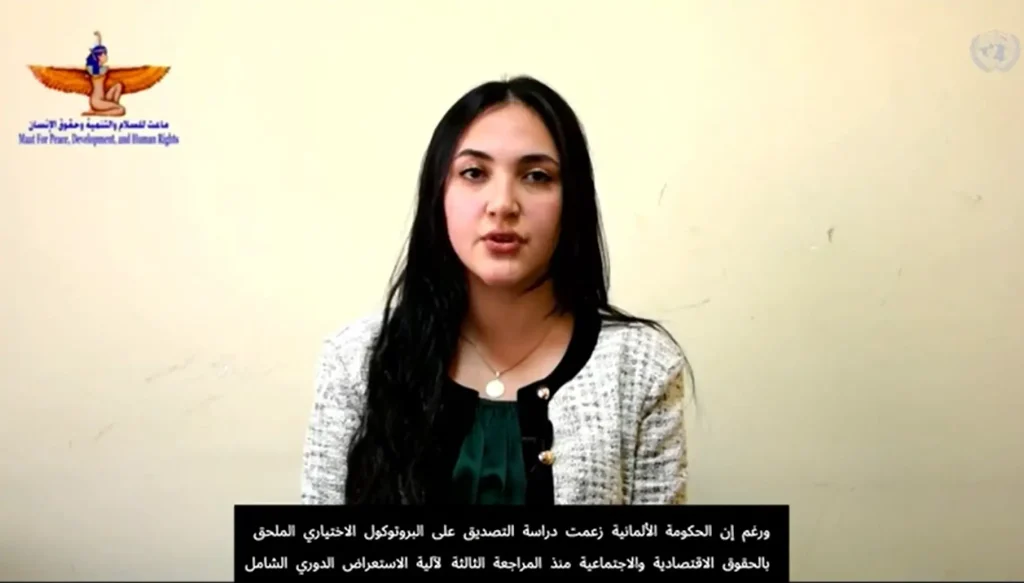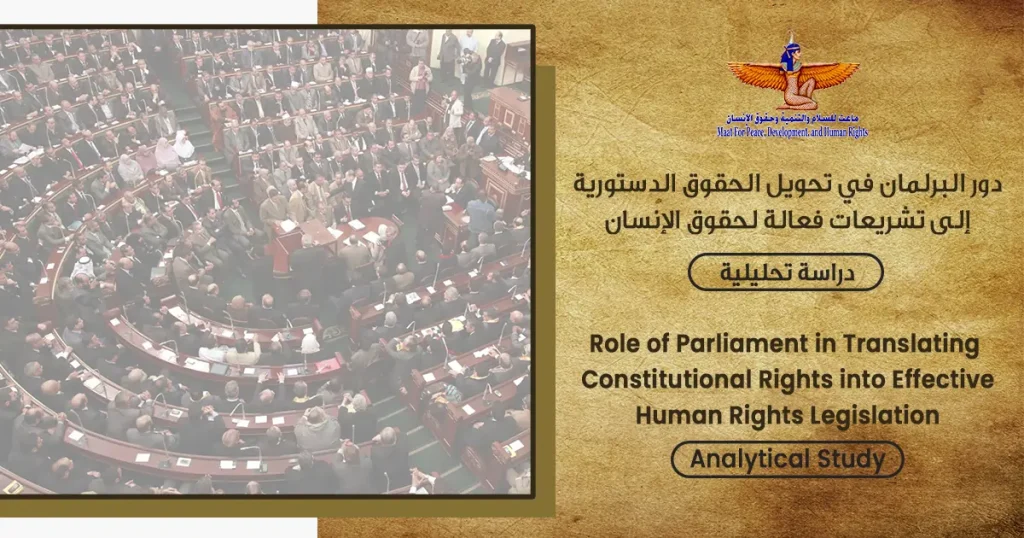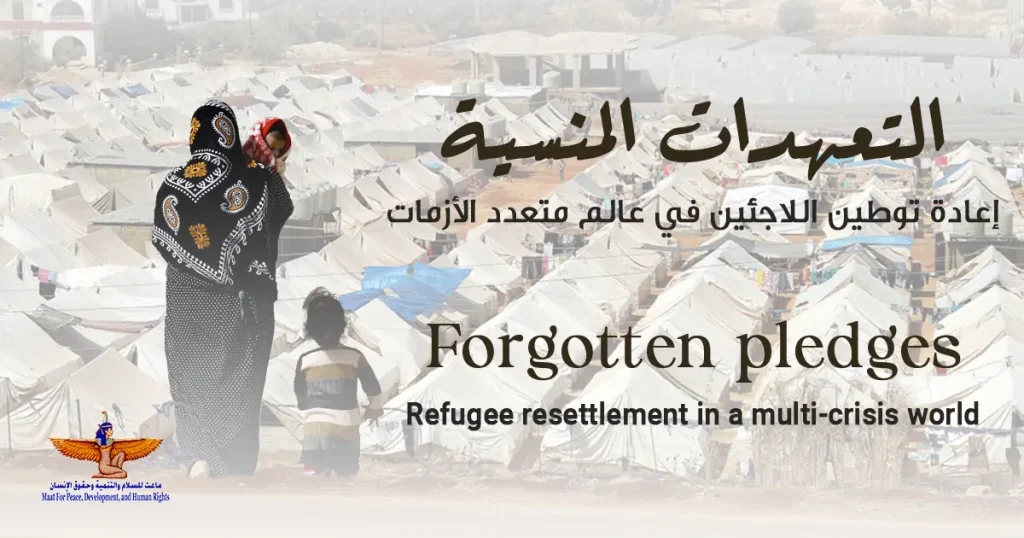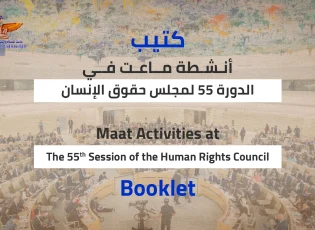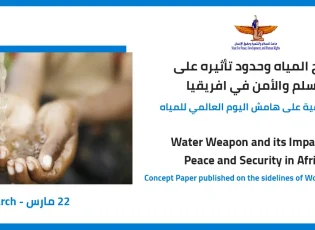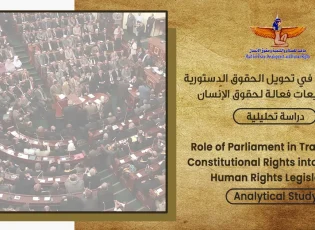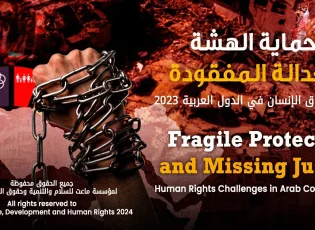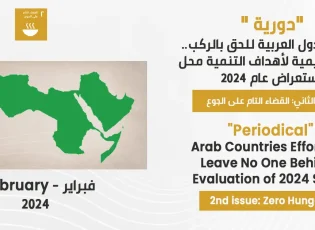A new vision for the development of legislation regulating the work of special groups
“Women, children and people with disabilities Disability ”
Policy Paper
Issued it
Public Policy Analysis and Human Rights Unit
Affiliate Foundation
, Maat for Peace, Development, and Human Rights
Under a project
The Universal Periodic Review as a Tool to Improve Public Policies during the Transition
June 2017
“This release was implemented with the help of the European Union. The content of this publication is the responsibility of the Maat Foundation for Peace, Development and Human Rights and can in no way be considered a reflection of the visions of the European Union.
Introduction:
Suffer  Some social groups suffer from the lack of suitability of work environment conditions to their needs and socio-economic conditions, especially in light of the political and economic changes that Egypt has witnessed in recent years. For example, we find that working women still suffer from legislative problems in various areas of Labor Law No. 12 of 2003, especially And that there is a prevalence of negative discrimination against women at the level of wages and the type of work required in most companies. This is in addition to the law’s failure to observe some of the implications of the woman’s physiological makeup, such as childbirth and breastfeeding.
Some social groups suffer from the lack of suitability of work environment conditions to their needs and socio-economic conditions, especially in light of the political and economic changes that Egypt has witnessed in recent years. For example, we find that working women still suffer from legislative problems in various areas of Labor Law No. 12 of 2003, especially And that there is a prevalence of negative discrimination against women at the level of wages and the type of work required in most companies. This is in addition to the law’s failure to observe some of the implications of the woman’s physiological makeup, such as childbirth and breastfeeding.
In the same context, child labor in Egypt is the most prominent problem. Rather, they perform hard work side by side with adult men, without regard for their childhood or the labor laws regulating child labor, which is a violation of their rights guaranteed by all international and local laws and charters.
In some workplaces, persons with disabilities suffer from negative discrimination towards them, which is not sufficiently taken into account by the law regulating workers' conditions in Egypt, especially in private companies.
And under interesting Public Policy Analysis and Human Rights Unit Foundation Maat for peace, development and human rights With the recommendations that were made to Egypt in light of the universal periodic review, the Egyptian government's position on the recommendations, and in light of the institution’s implementation of a project The Universal Periodic Review as a Tool to Improve Public Policies during the TransitionFunded by the European Union during 2016-2017, the Foundation has focused on shedding light on this issue through a paper that clarifies the most important problems and legislative solutions related to the employment of special groups, women, children and people with disabilities.
The paper dealt with the issue in several axes, as the first axis dealt with presenting an overview of the Egyptian labor law and the conditions of the special groups in the law, then in the second axis it moved to present the most important legislative problems for these groups, and in the third axis the paper talked about the constitutional and human rights status of these groups with highlighting The most important points that must be taken into account in the laws that regulate the work of these groups in accordance with international treaties and covenants ratified by Egypt with the presentation of the most important recommendations that Egypt committed to before the Human Rights Council during its submission to the universal periodic review mechanism, and in the last axis, the paper concluded with a set of recommendations that must be The legislator and the executive institutions take into account the work of these groups.
The first axis: the status of special groups in the Egyptian Labor Law
- An overview of Egyptian labor laws
Egypt is considered one of the countries in which there are many labor laws and it is not subject to one law that regulates the work relationship between the employer and the worker, because Egypt has a large number of different sectors, each of which is subject to a law that regulates the work relationship with it that differs from the other law and these laws
- The Civil Workers Law in the state, known as the “Civil Service Law” issued under No. 81 of 2016, its provisions apply to workers in ministries and government departments, agencies with their own budget, local government units, and employees of public agencies.
- Public Sector Employees Law 48 of 1978, which applies to employees of state-owned companies, has not been privatized or transferred to the private business sector system.
- Law No. 203 for the year 1991 of employees of public business sector companies, which mandated each company to issue internal regulations to organize its relationship with its workers.
- Unified Labor Law No. 12 of 2003, which replaced Law 137 of 1981, and applies to workers in the private sector, government and public sector, while there is no text in the laws regulating these sectors.
It should be noted that there are special provisions for some labor relations that are concerned with the employment of women, children and persons with disabilities. Other laws have been exempted from the exception to guarantee the rights of these groups, including Child Law No. 12 of 1996, amended by Law No. 126 of 2008, and Chapter V provisions related to the care of working children and mothers. The worker, which constitutes a unified and sophisticated organization of the rights of the child and the pain of the worker.
- The status of women in the labor law
The provisions regulating the work relationship between the working woman and the workplace in Law 12 in three basic points:
First: The provisions related to protection from discrimination in wages and the protection of working women from night work or dangerous or harmful work in terms of health or morals. These provisions related to protection and non-discrimination in articles come.
- Article (35) which stipulates the prohibition of discrimination in wages due to differences in sex, origin, language, religion or creed.
- Article (88) states that all provisions regulating the employment of workers shall apply to working women without discrimination among them whenever their work conditions are similar.
- Article (89) which states that the competent minister shall issue decisions determining the conditions, jobs and occasions in which women may not be employed in the period between seven in the evening and seven in the morning.
- Article (90) which stipulates that the competent minister shall issue a decision determining the jobs that are harmful to women in health or morally, as well as the jobs in which women may not be employed.
Second: Provisions for maternity protection, including maternity leave, rest for breastfeeding young children, and childcare permits:
- Article (91) which stipulates that a working woman who has been employed at the establishment of ten months shall be granted the right to obtain a maternity leave for a period of 90 days, with compensation equal to the wage, including the period preceding and following childbirth, and it is not permissible to work during the 45 days following childbirth, and she is not entitled to leave more than twice During the worker's service life.
- Article (92) which affirmed the prohibition of dismissing a worker or terminating her service during maternity leave.
- Article (93) which stipulates the right of a working woman who breastfeeds her child during the 24 hours following the date of childbirth in two periods of rest, each of which is not less than half an hour, or combining these two periods, which are calculated in the working hours and do not result in a reduction in the wage.
- Article (94) which stipulates the right for a female worker in an establishment that employs fifty or more female workers to have the right to leave him without pay for a period not exceeding two years to care for her child and is not entitled to more than twice during her service period.
Third: Childcare custody:
Article (96) stipulates that an employer who employs 100 workers or more in one place is required to establish a nursery or entrust a foster home to take care of the workers' children, according to the conditions and conditions that are determined by a decision of the competent minister. Firms that employ less than one hundred female workers in one region are also bound to participate in the implementation of the commitment stipulated in the previous paragraph with the terms and conditions determined by a decision of the competent minister.
- Rights of children and persons with disabilities in the labor law
- Child labor
The Egyptian Labor Law has designated some articles that regulate child labor, namely
- Article (98) which defines the working child and affirms that he is considered a child - in the application of the provisions of the law - whoever has reached the age of fourteen years or over the age of completion of basic education and has not reached the full seventeen years. Every employer who employs a child under the age of sixteen is obligated to give him a card proving that he works for him, and a picture of the child is affixed to it and approved by the competent workforce office.
- Article (100) which gave the competent minister the authority to issue a decision determining the system of child labor and the circumstances, conditions and conditions in which employment takes place, as well as the jobs and occupations and industries in which their employment is prohibited according to the different stages of age.
- Also, Article 101, which prohibits the child from working for more than six hours per day, and requires that the working hours be interrupted by one or more periods to eat and rest, totaling no less than one hour, and this period or periods are specified so that the child does not work for more than four continuous hours, and it is prohibited to work the child Additional working hours or operating it on weekly rest days and public holidays. In all cases, it is prohibited to employ the child between eight in the evening and seven in the morning.
- Article (102) obliges employers who employ one or more children to suspend an apparent statement at the workplace that contains a copy of the provisions of the separation of the law, and a list of working hours and periods of rest. The penalties for violating the articles of the Labor Law relating to children are in accordance with Article 248 of the same law ([1])To a fine of not less than five hundred pounds and not exceeding one thousand pounds.
As stipulated in the Child Law ([2]) No. 12 of 1996, as amended by Law No. 126 of 2008, to guarantee all rights of the Egyptian child, and to make the law the fifth chapter for the care of the working child and the working mother, and the law prohibits the employment of children in any work that may endanger his health, safety, or morals at risk ([3]).
- Employment of persons with disabilities
The Egyptian legislator has taken care of people with disabilities, as it has been keen since 1959 to address the problem of the handicapped, so Law No. 14 of 1959 regarding the vocational rehabilitation of the incapable of work and determining them was issued, then the articles of this law were incorporated into the labor law, then the legislator returned to regulate the issue according to Law No. 39 For the year 1975 with the amendment No. 49 of 1982 and it was called the Rehabilitation of the Handicapped Law.
The Rehabilitation of the Disabled Law No. 39 of 1975 stipulated in Article 9 that employers who employ fifty or more workers, whether they work in one place or country, or places or separate countries, must employ the disabled who are nominated by the Manpower Offices from the reality of the disability registry. Within the limits of 5% of the total number of workers in the entity in which they are nominated. Nevertheless, the employers referred to in the previous paragraph may occupy this percentage by employing the disabled other than by the method of nomination from the manpower offices, provided that the stipulated entry known as the “social qualification certificate” is obtained.
No provision related to the employment of persons with disabilities was mentioned in the Egyptian Labor Law No. 12 of 2003, which is currently in force, and the law does not contain any text that includes any positive discrimination for persons with disabilities in line with the charters and treaties that Egypt has ratified regarding the employment of that special group.
The second axis: the constitutional and human rights situation for these groups
- The constitutional articles regulating the work of these groups
- Article 11 of the Egyptian Constitution stipulates the establishment of the state to eliminate all forms of violence against women and in the workplace, and also stipulates the state's duty to protect motherhood and childhood, in the second paragraph of Article 11, which states “... the state is committed to protecting women against all forms of violence, And it ensures that women are empowered to reconcile family duties with work requirements. It is also committed to providing care and protection for motherhood and childhood, breadwinning women, the elderly, and women most in need.
- The Egyptian constitution defines the child for everyone who has not reached the age of eighteen, and it is forbidden to employ a child before he reaches the age of completion of basic education, and it is forbidden to employ him in jobs that put him at risk[4].
- Article 81 stipulates the rights of persons with disabilities at work when it stipulates that “the state shall guarantee the health, economic, social, cultural, recreational, sports and educational rights of persons with disabilities, and to provide them with employment opportunities, while allocating a percentage of them to them, …….”
- International charters and treaties
- The General Conference of the International Labor Organization approved charters specific to working women, such as the Convention on Equal Remuneration for Man and Worker Women for Work of Equal Value No. 100 of 1951, Convention No. 45 of 1935 on the Elimination of Discrimination in Employment and Jobs and Convention No. 89 of 1928 Concerning Night Work as well as Recommendation No. 123 of 1965 regarding the employment of women with family responsibilities ([5])
- Labor Organization Convention No. 183 of Maternity Protection for the year 2000, which stipulates that the worker obtain a fourteen-week maternity leave under Article 4 of this agreement ([6])
- Recommendation No. (165) regarding the Convention on Equal Opportunities and Equal Treatment for Male and Female Workers [7]Workers with family responsibilities, 1981, which emphasized the necessity of providing childcare facilities and family assistance, and this recommendation spoke of a commitment, without a specific condition, to the number of workers or workers in the establishments
- It defined the Convention on the Rights of the Child issued by the United Nations General Assembly ([8]) For the year 1989, the child is defined as “every human being below the age of eighteen unless he reaches the age of majority before that under the law applicable to him.” Several international institutions and charters have taken care of the rights of the child, and have taken care to protect the rights of working children who are deprived of protection because of their work, and has issued many agreements that At its forefront is the Convention on the Rights of the Child, which calls for the child's right to be protected from performing any work that is likely to be dangerous or to hinder the child, or to be harmful to the child's health, physical, mental, spiritual, moral, or social development.([9]). As well as setting an appropriate system of working hours and conditions, and imposing appropriate penalties to ensure the effective application of these texts.
- And the text of the ninth principle of the Universal Declaration of the Rights of the Child ([10])However, “a child may not be employed before reaching the appropriate minimum age, and it is prohibited in all cases to induce him to work or leave him to work in any profession or profession that harms his health or education or impedes his physical, mental or moral development.” However, among the efforts that took place before the issuance of both the Universal Declaration of the Rights of the Child and the Convention on the Rights of the Child, the International Labor Organization, since its founding in 1919, issued conventions and recommendations that regulate and protect child labor. Convention No. 138 was issued regarding the minimum age, and the Convention aims To gradually reduce child labor and raise the minimum age for child labor ([11])It also prohibited the employment of children up to the age of eighteen in jobs likely to endanger his health or safety.
- There is an agreement on the prohibition of the worst forms of child labor and immediate action to eliminate it ([12])This agreement complements Convention No. (138) with the aim of urging the elimination of the worst forms of child labor, as a prelude to the complete and total elimination of all forms of child labor, and it clarified among the acts prohibited to child labor, the work that by its nature or by the circumstances in which it is practiced Damage to children's health, safety, or moral behavior.
- One of the most prominent Arab agreements in this field is the Arab agreement ([13]) No. 18 of 1996 on juvenile labor, which is the first Arab convention specialized in the field of child labor. It was preceded by the Arab Agreement No. 1 of 1966 regarding work standards ([14]).
- He also emphasized the Universal Declaration of Human Rights[15] In the second article thereof, that all individuals without discrimination between any type or status enjoy all the rights stipulated in this declaration, which means equality between persons without disabilities and persons with disabilities.
- The Convention for Persons with Disabilities also affirms ([16]) To promote, protect and ensure the full enjoyment by all persons with disabilities, on an equal basis with others, of all human rights and fundamental freedoms, and to promote respect for their inherent dignity, as the convention sets a single and brief goal, so as not to leave room for any effort in its interpretation. As the agreement affirmed the equality of all fundamental rights and freedoms without exception. That is, it refuses to result in the existence of a disability any diminution of human rights, and that thought emerged clearly in Article Three and emphasized the principle of positive discrimination for persons with disabilities.
- Article 27 of the Convention on the Rights of Persons with Disabilities requires states parties to recognize the right of persons with disabilities to work, on an equal basis with others; This right includes providing them with the opportunity to earn a livelihood in a job that they freely choose or accept in a labor market and a work environment that is open to persons with disabilities, inclusive of them and easy for them to engage in. States Parties shall protect and promote the realization of the right to work, including the right of those who are disabled during their work, by taking appropriate steps, including enacting legislation, to achieve several goals, including the following:
- (A) The prohibition of discrimination on the basis of disability with regard to all matters relating to all forms of employment, including conditions of employment, appointment and work, continuity of work, career advancement and safe and healthy working conditions;
- (B) To protect the rights of persons with disabilities, on an equal basis with others, to just and favorable conditions of work, including equal opportunities and equal remuneration for work of equal value, safe and healthy working conditions, including protection from harassment and redress from grievances;
- (C) Ensure that persons with disabilities are able to exercise their labor and trade union rights on an equal basis with others;
- (D) Enabling persons with disabilities to have effective access to general technical and vocational guidance programs, placement services, and vocational and continuing training.
- (E) Promote employment opportunities and career advancement for persons with disabilities in the labor market, as well as providing assistance in finding, obtaining, maintaining and returning to work.
- (F) Promote opportunities for self-employment, entrepreneurship, the formation of cooperatives and starting private businesses;
- (G) Employ persons with disabilities in the public sector
- (H) Encouraging the employment of persons with disabilities in the private sector by adopting appropriate policies and measures, which may include corrective programs, incentives, and other measures.
- (I) Ensure that reasonable accommodation is provided to persons with disabilities in the workplace.
- (J) Encouraging the acquisition by persons with disabilities of work experiences in the open labor market.
- (K) Promote vocational and professional rehabilitation, job retention and return-to-work programs for persons with disabilities.
- States Parties shall also ensure that persons with disabilities are not subject to slavery or servitude, and that they are protected on an equal basis with others, from forced or compulsory labor.
- UPR recommendations
The Egyptian government was subjected to the universal periodic review mechanism in 2014, and received a number of recommendations related to the protection of special groups, especially women, children, and persons with disabilities, including: -
- Intensifying efforts aimed at empowering women and improving their status in society, adopting more measures to eliminate all forms of discrimination against them, enhancing their literacy, ensuring that they enjoy equal treatment and creating a safe environment in the workplace, combating gender-based violence presented by the state of Thailand
- Continue to take measures to promote and protect women's rights, especially in the workplace, provided by the State of Morocco
- Strengthening monitoring and regulation of domestic work provided by Senegal
- Consider introducing amendments to the labor law to include and protect domestic workers, and prohibit exploitative domestic work provided by the Philippines
- Strengthening efforts aimed at ensuring that women enjoy equal work opportunities provided by the State of Palestine
- Continue to work to ensure that women enjoy equal rights in the workplace through the institutions, rules and public policies of the state provided by the State of Bolivia
- Continue to promote and protect the rights of the child and provided by the State of Armenia
- Strengthening measures aimed at eliminating the economic exploitation of children, and amending the National Labor Law to bring it in line with International Labor Organization Convention No. 182 relating to the prohibition of the worst forms of child labor and immediate measures to eliminate it, recommended by the State of Serbia
- Continuing to create conditions for the participation of persons with disabilities in public life in the country and in decision-making in matters related to the realization of their rights provided by the State of Belarus
- Continuing efforts aimed at guaranteeing the rights of persons with disabilities and improving their integration into society provided by the State of Lebanon
The third axis: legislative problems for special groups in the labor law
- Legislative women’s problems in the labor law
Women suffer from three basic legislative problems in the unified labor law, namely: -
- The problem of discrimination in the provisions relating to protection from discrimination in wages
Despite the fact that international covenants that establish the right of women to work on the basis of complete equality with men, especially Article 23 of the Universal Declaration of Human Rights ([17])However, the Egyptian law does not meet women's aspirations for full and real equality in the field of work, as many owners of private sector companies specifically prefer men over women in jobs, due to the ease of movement of men, and thus the absence of their suffering under the special conditions of women, such as pregnancy, birth, breastfeeding and care, which They see it as a kind of loss, despite the provision of Article 35 that it is not permissible to discriminate in remuneration between women for any reason, including sex, and despite the existence of this text and the prohibition contained therein, the penalty for violating the provisions of that Article contained in Article 246, which states that The employer or his representative for the establishment that violates the provisions of Article (35) of this law and the ministerial decisions implementing it shall be punished. The fine is multiplied by the multiplicity of workers against whom the crime has occurred, and the fine is doubled in the event of recurrence, with a fine of not less than one hundred pounds and not exceeding five hundred pounds, which is a very small penalty that does not constitute a deterrent to the owner of the facility, and it is the main reason for the employers not abiding by the provisions of that article, and there is still clear discrimination in Wages among women and other workers.
In addition, Article (88) which explicitly states that it is impermissible to discriminate between women and other workers when working conditions are available. However, the text of that article is tainted by anaphylaxis in terms of not specifying a penalty for violating its provisions, and it contradicts the text of Article 89, which contains a ban on some work. Which women are not allowed to work with.
Where Article (89) and Article (90) stipulated some provisions related to the protection of working women from night work or dangerous or harmful work for health or morals, but in reality they are considered a form of negative discrimination against women as they confiscate her right, will, and freedom to make her decision about choosing Work according to the different conditions and needs of the woman, and the competent minister has absolute power to assess the cases of licensing or prohibition in order to achieve the interest of the labor market and it was better to make protection a license with the working woman that she appreciates according to her ability to work.
- The problem of maternity leave and nurseries to take care of the children of working women.
The Egyptian legislation came in contradiction to the recommendations of the International Labor Organization, which Egypt agreed to regarding giving birth permits for women, especially with regard to its duration. Article (91) stipulates the right of women to permit a full-paid birth, but the article stipulates that ten months have passed to serve the worker to benefit from this comfort, which is It is also a restriction on working women that undermines the logic of leave or its philosophy that is directed towards protecting motherhood and childhood, as it contradicts the essence of international conventions and most of the legislation in the world and what the Egyptian jurisprudence and judiciary has concluded that require women to enjoy this leave even in cases where pregnancy is not complete or the woman has not given birth In which the newborn is alive, taking into account the dangerous effects on the woman's health if she does not have adequate rest for at least six weeks after the birth process, as the birth permit is not only the right of the working mother, but it is the right of childhood and a duty and societal role in which the woman contributes, and the law is to guarantee and protect her ([18]). This article also violates Labor Organization Convention No. 183 on Maternity Protection of 2000 ([19]) Which does not require the elapse of a period of time for the worker in the workplace, which stipulated that the worker obtain a fourteen-week leave of absence, according to Article 4 of this agreement, and in Recommendation No. (191) related to this agreement, the necessity for states to seek to increase This period extends to eighteen weeks. The agreement also obligates the employer to provide the necessary health and social care for the mother during pregnancy and childbirth and for her child.
In the same context, women suffer from employers ’abuse in many cases as a result of employers terminating their work due to childbirth despite the provision of Article (92) prohibiting the dismissal of the worker due to maternity leave and the employer is satisfied with compensating the worker for terminating or terminating her work contract because the text of the article A penalty for violating its provisions was not received.
There are also many women's problems in the labor law, especially with regard to nursery homes in accordance with Article (96) of the Labor Law, which is marred by its failure to meet the needs of motherhood in contradiction with the consideration of motherhood as a social function and the responsibility to protect it reverts to the state and society according to the Child Law and it is unacceptable for women to bear their effects and burdens. This burden is represented in restricting the right to the number of times of childbearing under the pretext of confronting the problem of overpopulation, as if permitting maternity protection is the responsibility of the woman alone.
The woman also suffers from the continued cessation of the obligation to establish a nursery or for the employer to entrust another nursery with the care of the children of the workers, provided that there is a hundred workers, as this condition constitutes the abolition of this privilege as most of the establishment takes into account that the number of workers in it does not reach the number stipulated in the law for non-commitment to establish Custody and repudiation of this article.
- Exclusion of domestic workers, pure agriculture, and workers in the informal sector
In Egypt, the number of domestic workers has increased due to the economic conditions that the Egyptian state is going through, and because women are the most exposed group to this profession. And because the details and characteristics of that group differed from before, some of them are educated, university, and others are also looking for an honest living. Domestic workers are free from any legal protection on the grounds of the difference in the nature of their work and the existence of a direct connection with their employers in a way that enables them to see their secrets and private affairs despite the fact that Article 28 of the same law provisions relating to the organization of work of foreigners impose legal protection for foreign maids who work in Egypt, which is something that Negative discrimination against Egyptian women
The law also excludes women working in pure agriculture in a way that is inconsistent with the provisions of the Child Law, in addition to being a blatant violation and clear discrimination and a continuation of the historical injustice of women working in agriculture, and contradicts the direct provisions in international agreements related to women working in agriculture.
In general, the provisions of this law do not apply to all female workers in the informal sector, which is the sector that includes large numbers of poor female workers and the breadwinners of families who are subjected to harsher working conditions and conditions, including migrant workers, agricultural workers, construction workers, street vendors, cleaning workers and domestic workers
- Legislative problems related to child labor
Although Egypt has ratified many international conventions regulating child labor, in a way that guarantees them a decent life, and despite the existence of Egyptian legislation that is largely consistent with international agreements, whether through the constitution or the law, there is no absence of legal mechanisms to implement these legal texts that are in conflict with Some of them sometimes, according to Chapter Five of the Egyptian Child Law related to employment. Article 64 prohibits child labor under 15 years of age, which is inconsistent with Article 98 of the Labor Law, which stipulates that he is considered a working child as long as he is 14 years old. This is in addition to the failure of employers to abide by the age stipulated in any of the law and they employ children under the age of ten in some cases, especially in unlicensed workshops and industrial places.
Also, although Article 65 prohibited the employment of children in occupations that might endanger their safety or health, and also Article 66, which prohibited children from working for more than 6 hours a day and emphasized that they should not be employed between 7 pm and 7 am, but by live witnessing, we find business owners exploiting children In some dangerous occupations that harm their physical and psychological safety and health, in addition to using them for more times than what is stipulated in the law, due to the weakness of the penalty imposed on the employer in Article No. 74, which describes the penalties for violating the articles of Chapter Five with “a fine of not less than one hundred pounds and not exceeding five hundred fairy. The fine shall multiply according to the number of workers for whom the violation has occurred, and in the event of repetition, the penalty shall be increased by an equal amount, and its execution may not be suspended. Which requires modification of the article.
The law also did not take into account those who work in pure farming, and their final exclusion from the law according to Article 102 ([20]Of the Egyptian Labor Law, which must be remedied in law amendments
- Problems of the rights of persons with disabilities in the labor law
The status of the right of persons with disabilities to work in Egyptian law is completely far from all international agreements and is considered more backward than all Arab laws in this context. The Basic Law for Persons with Disabilities, Law 139 of 1975 clearly adopts the vision of disability and deficiencies in Articles 1 and 2 and then goes into Article 5 of it to determine the percentage of employment opportunities allocated to people with disabilities at a percentage of 5% only from the number of workers in establishments in which the number of workers exceeds 100 persons, which opens the door to circumventing this percentage by not registering the owner of the establishment the number of official workers and making it always under the number obligatory to employ people with disabilities
The penalty set by the law for violating this percentage is one month imprisonment, a fine of 100 to 5,000 pounds, or one of the two penalties in Article 16, which allows him to pay the fine in exchange for non-compliance with the employment of persons with disabilities.
Also, the first article of the Unified Labor Law 12 of 2003 is considered an exclusionary article that excludes persons with disabilities from being subject to the law, as it defined in its first article the worker as (every natural person who works for a wage for an employer and under his management or supervision). Nevertheless, the law maintained the 5% rate. Specified by Law 139 of 1975, which allocated special records to register those wishing to have a disability, which is considered a conflict between the articles and some of them.
Fourth Axis: Recommendations and proposals.
- Legislative amendments required to amend the conditions of special groups in the Labor Law
First: the woman
- Amending Article 88 of the Labor Law by adding an appropriate penalty for those who do not apply the law so that the article becomes “… all provisions regulating the employment of workers shall be applied to women workers, without discrimination among them whenever their work conditions are similar. Whoever violates this article will be punished with a fine of not less than 10,000 and not more than 20,000 Egyptian pounds.
- To pass Article 89 to read “The Concerned Minister issues a decision determining the conditions, jobs and occasions in which women may not be forced to work and employ them, especially in the period between seven in the evening and seven in the morning.”
- Amending Article 90 of the law to read: “The competent minister issues a decision determining the jobs that women may not be forced to work and classifying them as work harmful to women health or morally, as well as jobs in which women may not be employed forcibly.”
- Amending Article 91 to comply with Labor Organization Convention No. 183 on Maternity Protection for the year 2000 stating that “an employee has the right to obtain a maternity leave for a period of 14 weeks, including the period preceding and following childbirth, provided that the period of this leave after childbirth is not less than forty-five days, provided that To present a medical certificate indicating the date on which the delivery is likely to occur, and this leave is paid, and in all cases the worker is not entitled to this leave more than three times during the period of her service. The father is entitled to obtain his postpartum maternity leave in case the mother dies or suffers from a disease with which she is unable to care for the child.
- Amending Article 96 to read “… an employer who employs fifty or more female workers in one place must establish a foster home, or entrust a foster home to take care of the workers’ children, according to the terms and conditions determined by a decision of the competent minister. The establishments that are located in one area and each employ less than fifty workers, are obligated to participate in the implementation of the commitment stipulated in the previous paragraph, according to the terms and conditions determined by a decision of the competent minister.
- An article will be added to the law stipulating the punishment of anyone who harasses a woman while working in accordance with Article 306 bis (a), (b) of the Egyptian Penal Code
- Incorporate Egyptian domestic workers into the labor law while providing legal protection for them, such as foreign domestic workers.
Second: Children
- Amending Article 98 to read “It is forbidden to employ children before they reach fifteen years of age. Nevertheless, they may be trained when they reach thirteen years of age in a manner that does not hinder them from continuing their education. Every employer who employs a child under the age of sixteen is obligated to give him a card proving that he is training or working for him, and a picture of the child is affixed on it, and it is approved by the competent administrative authority and stamped with its seal.
- Amending Article 100 of the Law to stipulate that “Child labor, and the conditions, conditions, and conditions in which employment takes place, the jobs, occupations, and industries in which their employment or training is prohibited shall be according to the different age stages, according to the system established in accordance with the provisions of the Child Law.
- Amending Article 74 of the Egyptian Child Law relating to the penalty for anyone who violates the provisions of child labor according to the Labor Law and the Child Law to read “” Anyone who violates the provisions of Chapter Five of this law shall be punished with imprisonment for a period of no less than three months and not more than six months, and a fine of no less than five Thousands of pounds and not exceeding one hundred thousand pounds, or either of these two penalties, and the fine shall be entrusted to the injured child as a kind of compensation by the employer.
Third: Persons with disabilities
The Egyptian Labor Law did not concern itself with regulating the employment of persons with disabilities that it was satisfied with what was stated in Law No. 39 of 1975 relating to the rehabilitation of persons with disabilities. Therefore, we suggest adding some articles to the Labor Law to regulate the work of this category, namely: -
- Increasing the percentage of commitment to employ workers with disabilities to 7% from the number of workers in the establishment whose number of employees exceeds 50 in one branch or in all its branches combined.
- Establishments existing at the time of application of this law and those established in the future are obligated to return to the administrative authority the employee registration certificate issued by them within forty five days from the date of receiving the work after completing the data recorded therein, and they must record the number of the registration certificate and its date in front of the name of the worker in the workers registration register In the facility
- The establishments referred to in the previous article are obligated to hold a special register to record the names of people with disabilities and dwarves who have qualification certificates who have been assigned to work for it, and it includes the data contained in the qualification certificates, and this record must be submitted to the competent administrative authority whenever it is requested to do so. That authority must be notified with a statement that includes the total number of workers, and the number of jobs occupied by people with disabilities and dwarves.
- Without prejudice to the provisions of the Child Law promulgated by Law No. 12 of 1996 and amended by Law No. 126 of 2008, the rehabilitation authorities shall notify the competent administrative authority in whose jurisdiction the place of residence of the child with a disability or the dwarf child is located of the benefit of his rehabilitation, and the names of the children who have been rehabilitated are registered in the register. Private, and the child with a disability or a dwarf child, or his representative, received the registration certificate free of charge. The competent administrative authority is obligated to assist children with disabilities and the dwarf children who are registered with it in joining the jobs that suit their ages, sufficiency and places of residence, and it must notify the Social Solidarity Directorate located in its department with a monthly statement on children with disabilities and pygmies who have been employed. And the wage that each of them receives, according to the form and date specified by a decision issued by the competent minister.
- A worker with disabilities is entitled to an annual leave with pay, and the days of holidays, official occasions and weekly rest are not included in the account of forty-five days for people with disabilities. The leave may not be divided, combined, or postponed for people with disabilities.
- Suggestions and recommendations for governmental institutions and civil society to amend the conditions of special groups and protect them at work
- The government shall integrate and qualify workers with disabilities at work through the obligation to specify the percentage determined for them in available government jobs.
- Activating the role of gender units deployed in all government agencies and departments to play their role in spreading the culture of gender and resisting processes of discrimination against women
- Tightening control over facilities that use children to ensure that children fully enjoy their rights stipulated by law.
- Civil society institutions strive to end discrimination and violence, promote equality between women and men, and activate women's participation by integrating the concept of gender and enhancing the participation of men in this process through continuous courses and workshops in enterprises and institutions with heavy labor.
- The commitment of civil society organizations, especially women's institutions, to provide legal guidance to female workers to inform them of their rights and duties towards the institutions, companies and establishments in which they work.
[1] Egyptian Labor Law, Chapter on Labor Inspection and Judicial Seizure, Article 248.
[2] Egyptian Child Law No. 12 of 1996, as amended by Law No. 126 of 2008
[3] Articles “64, 65, 66, 67, 68 and 69 of the Egyptian Child Law No. 12 of 1996, as amended by Law No. 126 of 2008.
[4] The Egyptian Constitution of 2014, Chapter of Rights and Freedoms, Article 80.
[5] Research on women's rights in international covenants with application to the Egyptian case - http://democraticac.de/?p=2470
[6] Labor Organization Convention No. 183 Protection of Maternity in 2000 – http://www.labor-watch.net/ar/paper/144
[7] Recommendation No. (165) regarding the Convention on Equal Opportunities and Equal Treatment for Male and Female Workers http://hrlibrary.umn.edu/arabic/R165.pdf
[8] The first article, the initial part of The United Nations Convention on the Rights of the Child of 1989.
[9] Convention on the Rights of the Child, Article 32, paragraph 1.
[10] 1959 Universal Declaration of the Rights of the Child, Principle 9.
[11] Minimum age agreement for admission to employment, signed in Geneva on 6/6/1972, entry into force 6/19/1976.
[12] Convention No. 182 on the Prohibition and Immediate Action for the Elimination of the Worst Forms of Child Labor, 1999
[13] This agreement prohibits the use of a child under the age of thirteen years of age, and that child labor is monitored in all cases and examinations are conducted annually to ensure their ability and health fitness to work.
[14] Article No. 58 of the Arab Convention No. 1 of 166 Concerning Levels of Work: Juveniles before the age of seventeen may not be employed in industries that are hazardous or harmful to health specified by legislation, decisions, and regulations within each country.
[15] Universal Declaration of Human Rights http://hrlibrary.umn.edu/arab/b001.html
[16] The Convention on the Rights of Persons with Disabilities http://bit.ly/2fzppMX
[17] - Article 23 of the Universal Declaration of Human Rights, paragraph 2 - Everyone, without any discrimination, has the right to equal pay for equal work.
[18] - Maternity protection advances amid huge global gaps - Report by the International Labor Organization's Middle East Regional Office - http://bit.ly/2qfcPwt
[19] Labor Organization Convention No. 183 Protection of Maternity in 2000 – http://www.labor-watch.net/ar/paper/144
[20] Article 102 Of the Egyptian Labor Law and stipulating that “… The provisions of Chapter Three of this Chapter do not apply to children who work in pure farming.



